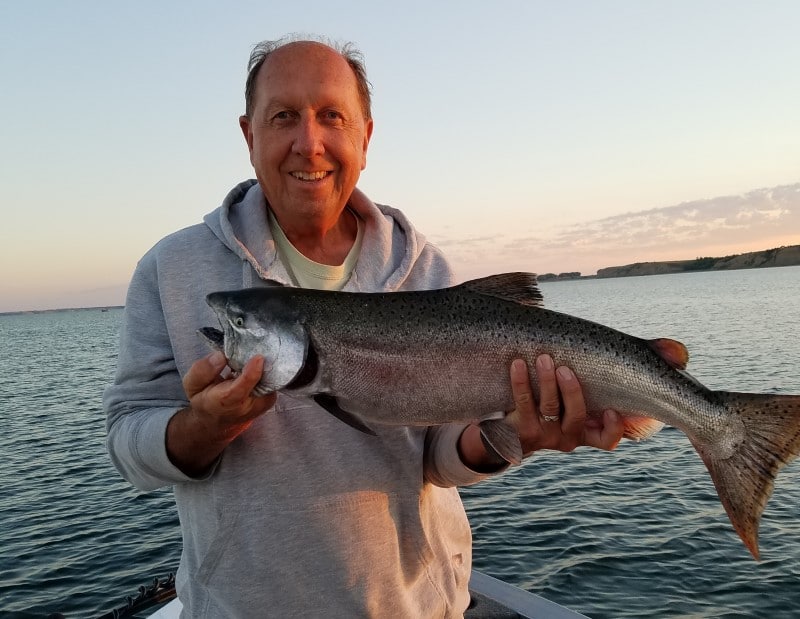Summer is coming and this signals the time of year when we search for kings amongst our favorite waters. These kings I speak of are the Chinook Salmon. And here, it’s salmon trolling season.
I spend a lot of time pursuing salmon in my favorite waters and occasionally travel to new ones. There are several things that hold true everywhere when it comes to salmon trolling, and I will explain in detail.
There are several keys to putting more fish in the cooler and less frustration on the mind.
First Key is Understanding the Water Temperature. The ideal temperature range for Chinooks is usually 45 to 60 degrees. Many feel that 54 degrees is the prime feeding temp for these cold water inhabitants. You’ll want to be looking at wind patterns and finding key temp breaks that concentrate the fish. This is crucial in eliminating unproductive water on the large bodies of water that hold these fish.
Trolling Speed for Salmon
Trolling Speeds. There are many opinions out there on what speed to troll. The body of water dictates this I’ve found. Anywhere from 1.8 to 3 mph is the best. But I have heard as high as 4 mph on the Great Lakes. Speed replication to me is what is the most important. When you find that speed that catches a fish, try to replicate that as best as possible. Dial in that speed and dial up a cooler full.
Salmon Trolling Direction. Some ask why is this important? First off it depends on the fishery makeup. Fishing current, wind direction, and light penetration can all play into factors of the trolling direction. Ease of setup to start my day is always taking into consideration. I always try to set up with the wind or current.
Also, far too many people troll a straight line. I try to never pull a straight line no matter what I’m trolling for. This causes baits to speed up and slow down, triggering strikes. The changes in speed and angle some days are keys to triggering fish.

The Fourth Key is Understanding Baitfish. Let’s be honest, salmon are eating machines and they are constantly on the hunt. Far too often I have found that chasing a spot or a bite to only find no bait and hence, no fish. One thing I have learned is these predators will not be far from the buffet. If you are in an area and not marking bait, MOVE! If you are around lots of bait and marking fish, be patient, they will put on the feed bag.
Trolling Rigs and Lures
Salmon Trolling Bait Selection. Match the hatch is my motto. Closely replicating the primary forage most of the year seems to always yield better results. On some lakes, matching size is critical some days on the water. Color also seems to come into play depending on the lake system.
UV and Glow seem to factor in on low-light time periods. UV is the go-to bait color for a lot of anglers where others think it’s a gimmick. I for one, believe it is essential during low light periods to increase strikes.
Sixth Key is Quality Fishing Line. I don’t care if you use mono, braid, wire or fluorocarbon; you need a quality fishing line or wire. Good knots are also important, but the fishing line to me is well worth a solid investment. Salmon trolling in general, let’s be honest, is an investment. Line or wire should not be the place to cut corners.
The fishing line you choose is the connection to your fish. Tying my own salmon rigs, I have switched to all fluorocarbon leaders not just for low visibility but also its abrasion qualities. One thing I have learned the hard way is kings will test your gear.
Quality Trolling Gear! You can argue till you’re blue in the face about what brands are better than others. My rule of thumb is to buy the best you can afford. Many anglers swear by a certain brand of rods and reels. I am a guy that looks for the best bang for the buck.
Now we all have been lured by those bargain ads on Facebook or Amazon. To quote a famous movie line…“it’s a trap!” You should always spend good money on your trolling rods and reels. Especially if you use dipsy or wire setups. Cheap gear will just cost you more in the long run. Ask around, other fishermen will tell you what works and what doesn’t.
Downriggers are the same. Do you need electric retrieve? No. Are they nice? Yes, but again, buy what you can afford.

Knowing Your Electronics. Today’s depth finders are miles ahead of what they were 10 years ago. The advent of side and down scan has given today’s angler a photograph of the water below us. Use this tool to paint a better picture of what the bait and fish are doing.
Also, the mapping programs and built-in depth contours have become a trollers bible of where and what to fish. Finding structure in vast amounts of water with these tools has become a game changer. I think you should invest in as much as you can afford, but by no means spend the family budget. A good investment here will pay off with years of use.
The Ninth key is Scent. Whether it’s putting meat down on meat rigs or using herring oil, it all helps. After all, we are chasing a fish that can smell its birthplace.
Many skippers on the West coast swear by washing your tackle with lemon Joy is essential to success. Some guys swear by herring and tuna oil. I just think a mixture of scent and artificials are always a good thing. Keeping as much human scent off your lures is always a good practice for all fish species.
My final key is Education. I don’t care where you’re salmon trolling for kings, always learn from your time on and off the water. It’s always a great day on the water but if you learned something, it’s even better.
Salmon trolling guys seem to be more open to teaching. I am always watching videos and reading articles; doing whatever it takes to make myself a better fisherman.
Remember, give a man a fish you feed him for a day. Teach him to fish you have just made his life awesome. Oh yeah, feed him for life. Hopefully, I have shed a little light on the Game of Trolling for Kings.
HiTech Redneck Out! Check out my salmon trolling video tips below. I talk about beginner tips on keeping the rods DOWN & TIGHT. I also dive into the brine conversation of whether or not to use it with herring while trolling for salmon.
